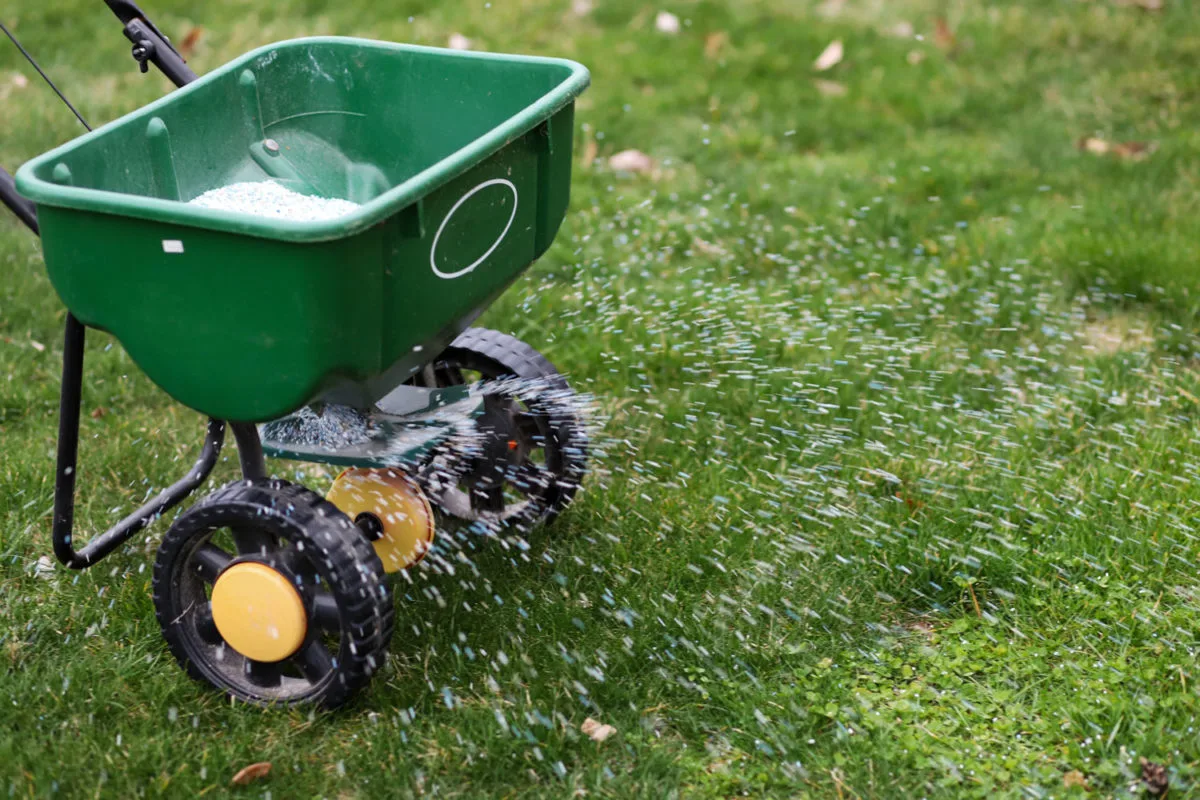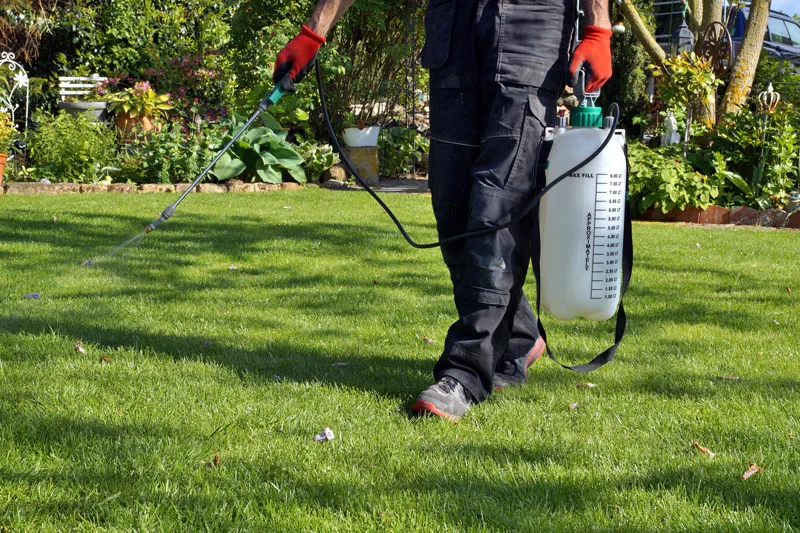Our beginners guide to feeding your lawn is designed to take the stress out of applying fertiliser.
New to lawn care? Feeling overwhelmed with all the information available? Never fear, our beginners guide to feeding your lawn will make sense of all things fertiliser. We’re going to be looking at the equipment you’ll need, how to choose the right formulation for your lawn, and what you can do to give your grass an extra boost of nutrition.
We’ll be answering questions like
- How do you know if your lawn needs feeding?
- What equipment do you need for feeding your lawn?
- Which is the best fertiliser to buy?
- How often should you feed your lawn?
- What happens if you make a mistake feeding your lawn?
Introduction To Feeding Your Lawn

Robbie Lynn is a trained greenskeeper who has plenty of sound advice for lawn care beginners.
Follow Robbie’s YouTube Channel for regular hints and tips to help you get the best from your lawn.
Your lawn is a living thing – actually it’s lots of living things packed into one space – and as such it needs food. Just like you. In many ways, feeding your lawn is very much like feeding yourself. It needs regular meals, and a balanced diet that is tailored to the type of work it has to do. OK, so your lawn doesn’t actually go out and earn money, but if you think of ‘work’ as something that uses up energy reserves, being walked on and mown, is work for grass. We’ll look at that later.
So to recap, feeding your lawn involves
- Regular fertiliser application – that way nutrients are replenished as they are used up and your lawn never becomes ‘hungry’.
- Ensuring that your grass plants can access all of the nutrients they need.
- Adjusting the balance of nutrients to suit the type of lawn you have.
- Being aware that nutrient needs change during the year.
How do you know if your lawn needs feeding?
Every lawn needs regular feeding, unless you are growing a wildflower lawn – but that’s a whole different blog’s worth of information.
No matter what time of year it is, If its been 6 weeks or more since your lawn was last fertilised, it needs feeding. Simple.
Think of the soil beneath your lawn as a bank account for plant nutrients. If the balance in the account gets too low, then the grass doesn’t have enough food to draw from and it starts to make compromises – cell walls may not be as strong as they could be, roots will be shorter and weaker, the grass coverage will be thinner. Keeping the ‘bank account’ topped up with the right nutrients, gives your lawn the best chance of thriving.
For advanced lawn care, or for your own interest, you could invest in a soil testing kit to find out what the levels of nitrogen, phosphorus and potassium are in the soil beneath your lawn. Make a note of the results and test again in a few weeks time to see how well your lawn feeding regime is working.
What Equipment Do You Need For Feeding Your Lawn?

A fertiliser spreader like this is essential equipment for feeding your lawn
Its absolutely essential that fertilisers and lawn tonics are applied evenly across your lawn. Otherwise you’ll end up with odd looking light and dark patches of grass. But don’t worry, for a relatively small investment, you can get simple applicators that will do the job very well indeed. If you have a large lawn, you might want to upgrade to professional standard spreaders in time. But for now, let’s keep it simple.
You will need:
- Wheeled spreader for granulated fertiliser. Preferably one that can be calibrated.
- Small sprayer to apply liquid lawn tonic
- Measuring jug (only to be used for lawn care!)
- Protective gloves
- Hosepipe and sprinkler
Take a look at my online shop for recommendations.
Which Is The Best Lawn Fertiliser To Buy?
In order to work out which fertiliser is best for your lawn, you need to understand which nutrients your lawn needs – and when.
Understanding your lawn’s nutritional needs
We humans need protein for growth, fats and carbohydrate for energy and a raft of vitamins and minerals to keep us healthy. Doctors refer to these as macronutrients (the things we need a lot of) and micronutrients (miniscule amounts but they’re important.
For grass, the macronutrients are Nitrogen, Phosphorus and Potassium and micronutrients include iron, sulphur, boron, zinc, calcium and others.
Here’s where it gets a bit more complicated. Because humans usually live indoors with artificial heating and lighting during the winter months, our nutritional requirements stay more or less the same all year round. BUT your lawn lives outdoors where the temperature and the length of the days changes with the season. This affects the type of nutrition needed.
Grass gets some of the energy it needs for growth from the sun – when the days are shorter, energy supply is depleted, so the grass doesn’t grow as much. Which means that we don’t need to mow it as often.
Remember earlier in the article when I explained that being mown is the grass equivalent of us doing hard work? In spring and summer, when we’re mowing more often, grass needs to have access more nutrition than it does in the winter time. However, in winter, the roots are still functioning and all of the cells need to protect themselves against frost – so some food is still essential.
Summer Vs Winter
In spring and summer, your grass needs nitrogen to support rapid growth, phosphorus for root growth and potassium to help it fight off diseases.
In autumn and winter, your lawn will need less nitrogen but will still need phosphorus and potassium.
Those micronutrients are important all year round. I recommend applying a seaweed based lawn tonic roughly once a month.

Liquid lawn tonics should be applied with a sprayer – try to avoid using the same sprayer that you use for herbicides – any cross contamination could be disastrous for your lawn.
How does mowing affect lawn nutrition?
As a trained greenskeeper I can confirm that different mowing regimes do call for different types of lawn feeding. So do different types of lawn. A football stadium for example takes a real hammering during the season and – just like a human athlete, the feed needs to be adjusted accordingly. On a golf course, we mow the greens every couple of days to keep them uber-short. That can be a strain on the grass too and we do need to feed them more often than you would feed a domestic lawn.
As a beginner though, you don’t need to worry too much about mowing and nutrition. Keep it simple to start with. For a family lawn, it’s enough to apply a good quality, proprietary lawn feed once every 6-8 weeks throughout the year. Be sure to use the correct formulation for the time of year though.
Which Type of Lawn Feed Should I Use?
The fertiliser you buy will depend on the time of year you want to apply it. Feeding your lawn well, means using a different balance of nutrients at different times of the year.
- Look out for spring/summer formulations of NPK (Nitrogen, Phosphorus, Potassium) lawn feed to use between March and September.
- From October to February, use an autumn/winter formulation.
- Apply micronutrients on a monthly basis all year round
Liquid or Granular Fertiliser?
For beginners, I always recommend feeding your lawn with a granular fertiliser. It’s far easier to apply evenly, and any excess can happily be stored in a cool dry place until you need it. Granular lawn feed naturally works its way through the grass sward to the soil where it is needed. Always water in granular fertilisers – if the crumbs sit on the grass leaves for too long, they can leave ugly brown scorch marks.
Micronutrients are best applied in liquid form because they are often absorbed through the leaves as well as through the roots.
What about weed and feed treatments?
Personally, I’m not a fan of weed and feed treatments unless the lawn is infested with unwanted plants. All you are doing is polluting the planet with herbicides that really don’t need to be there. It’s far better to dig weeds out if you can. Either that spot treat them with weedkiller so that you only apply the minimum amount of chemical.
How Often Should You Feed Your Lawn?
You like your meals to be fairly regular don’t you? Well so does your lawn. Always check the manufacturers recommendations for the fertiliser you have brought, but as a rule of thumb you should be feeding your lawn with an NPK feed every 6-8 weeks. For foliar feed – I would recommend applying it every 4 – 6 weeks.

A well fed lawn looks vibrant and healthy with a beautiful deep green colour to it.
What Happens If You Make A Mistake When Feeding Your Lawn?
Mistakes happen, and it’s never the end of the world. You may feel cross with yourself for a while, but you’ll learn a valuable lesson.
Common mistakes include:
- Applying too much fertiliser at once….too much fertiliser can burn your lawn. As soon as you’ve realised what’s happened, water, water, water and keep watering every day for a week to try to wash away the excess feed.
- Filling your lawn spreader whilst it sits on the lawn. NOOOOOOO NEVER do this – if you accidentally spill some of the lawn feed it will burn a patch of lawn. You’ll be left with a really ugly scorch mark that takes months to grow out. If this happens to you and you need to fix it in a hurry, you’re best course of action is to dig out that patch of lawn, add fresh topsoil and re-seed it.
- Uneven fertiliser application. Are you seeing dark and light stripes in your lawn? That’s probably because you’ve managed to get more fertiliser in some areas and no fertiliser in other areas. Don’t worry, it’ll even up in time. Next time you feed your lawn, it might help to put pegs at either end of the lawn. Space them at the width your fertiliser spreader works to and focus on one peg as you walk along the lawn. It will help you to walk in a straight line and get the distance correct.
- Too little fertiliser applied – that’s not a problem at all. There’ll be no harm done. Just bring your next scheduled lawn feed forward a couple of weeks so that the nutrient bank in the soil gets topped up sooner. Learn out how to calibrate your spreader so that you get the application rates right next time.
- Spilling fertiliser or lawn tonic on paths and patios. Oooops! It happens, but some types of stone will stain. Sweep up as much as you can and then use lots of water with a little bit of washing up liquid to wash off the rest. Talk to your stone supplier if you think you need to use a specialist cleaning agent.
- Using the wrong formulation for the time of year.
- If you’ve used a spring – summer formulation in autumn or winter, your lawn may be more susceptible to fungal diseases. Be vigilant and treat diseases as soon as you see them. Make sure you don’t skimp on the seaweed tonic – that will help boost your lawns resilience to disease.
- Using and autumn winter formulation in spring or summer won’t do too much harm, especially if you feed your lawn regularly and the mistake only happens once. Get back to your regular lawn feeding regime as soon as possible.
Hint and Tips on Feeding Your Lawn
For a video version of my beginners guide to feeding your lawn, head on over to my YouTube channel where you’ll also find lots of information on mowing, lawn renovations, controlling moss, watering your lawn and much much more.
For more helpful hints on feeding your lawn, take a look at our lawn care calendar
